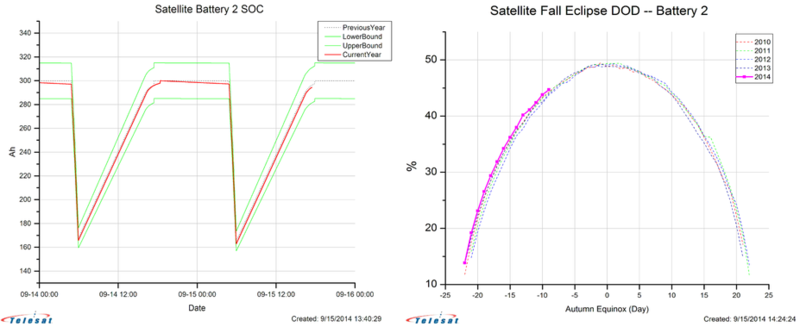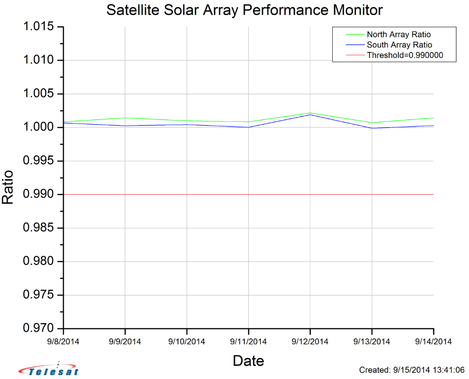Origin to Enhance Satellite Fleet Operations through Automation
|
"OriginPro has helped Telesat redefine the way in which Satellite Engineers monitor and assess satellite performance across all on-board subsystems"
In 1972 Telesat launched Anik A1, the world's first domestic communications geostationary satellite. Since that time, Telesat has grown to become a leading global satellite operator, providing reliable and secure satellite-delivered communications solutions worldwide to broadcast, telecom, corporate and government customers.
In 2014 the company, which is headquartered in Ottawa, Canada, with offices and facilities around the world, was named “Global Satellite Operator of the Year” by a panel of industry experts. Its current fleet, which supports a variety of services including direct-to-home television, data, and voice communications, consists of 14 satellites plus the Canadian payload on ViaSat-1 and additional satellites which it operates for third parties. Telesat’s operational fleet will continue to grow with its plans to build more satellites in the coming years.
Here, Steve Reid from Telesat highlights how the company’s use of Origin allowed them to automate the telemetric verification processes which, in turn, led to increased efficiencies in supporting the 24/7 operations of Telesat’s global satellite fleet.
| |
| Organization Telesat (Leading Global Satellite Operator)
|
| Problem
Automate routine fleet operation procedures such as tracking on-board subsystem health and performance to increase efficiency.
|
| Solution Interface with Telesat’s Scalable Data Management System (repository that retains telemetry data for all Telesat satellites) and effectively meet all requirements for data handling, data throughput, and automated analysis and graphing.
| | Key Features
|
|
Over the past six years Telesat has made numerous changes to its fleet operations to enhance efficiencies through automation. As a key example of this effort, all routine operations within Telesat’s Satellite Control Center (SCC) are now conducted using automated procedures run from master schedulers residing on the fleet control systems. These procedures perform all commanding and telemetry verification without the need for operator intervention. This automation effort has allowed Telesat to significantly increase the size of the in-orbit fleet under management while maintaining staffing levels and standardizing operations that ensure overall fleet safety and transponder availability.

Figure 1.a) STARS has a monitor routine that compares historical battery discharge/charge profiles against near real-time battery performance telemetry during eclipse seasons. Figure 1.b) A seasonal overlay of battery depth of discharge.
Although substantial improvements had been made to SCC operations through procedure automation, Telesat’s Satellite Engineers continued to manually perform telemetry data trending and analysis for all satellites within the fleet. Without automation, this task, which is performed to track on-board subsystem health and performance, can often be complex and consume many hours in each week. The in-house tools that the engineers used to perform telemetry trending did not lend themselves to automation and, as a result, changes were needed to bring this task in line with other recent operational enhancements. After conducting an in-depth study on how best to improve existing in-house software for trending, Telesat contacted OriginLab for a demo of OriginPro. After several months of testing, Telesat Satellite Engineers had amassed sufficient data to show that OriginPro could interface with Telesat’s Scalable Data Management System (SDM is a repository that retains telemetry data for all satellites within Telesat's fleet) and effectively meet all requirements for data handling, data throughput, and automated analysis and graphing.
With the Origin-SDM framework in place, Telesat's Engineers began development of a secure Web-based portal that would provide up-to-date fleet health status through analysis of key satellite subsystem telemetry parameters. This system, named STARS (Satellite Telemetry Analysis and Reporting System), which engineers can access through a secure remote connection, retrieves data from SDM and, using OriginPro, performs various forms of analysis to provide an automated health assessment and indicator of any unexpected change in subsystem performance. As an example of the type of analysis that can be performed, STARS has a monitor routine that compares historical battery discharge/charge profiles against near real-time battery performance telemetry during eclipse seasons (shadow periods that are centered about the Vernal and Autumnal Equinox) [fig 1a]. Through a single dedicated web page, operations personnel are provided a real-time view of the battery performance across the entire fleet. This application also provides notification in the event the discharge/charge profile of any on-board battery were to deviate from expected performance. When compared to previous eclipse season monitoring methods, which were based on control system limit thresholds and manual review of telemetry data, this application is a much more comprehensive and intuitive solution. Other examples of automated power subsystem analyses within STARS include a seasonal overlay of battery depth of discharge [fig 1.b] and a daily comparison of solar array output performance [fig 2].
OriginPro has helped Telesat redefine the way in which Satellite Engineers monitor and assess satellite performance across all on-board subsystems. In addition Telesat is deploying OriginPro across other platforms in its continued effort to enhance satellite fleet operations through automation.

Figure 2. A daily comparison of solar array output performance.